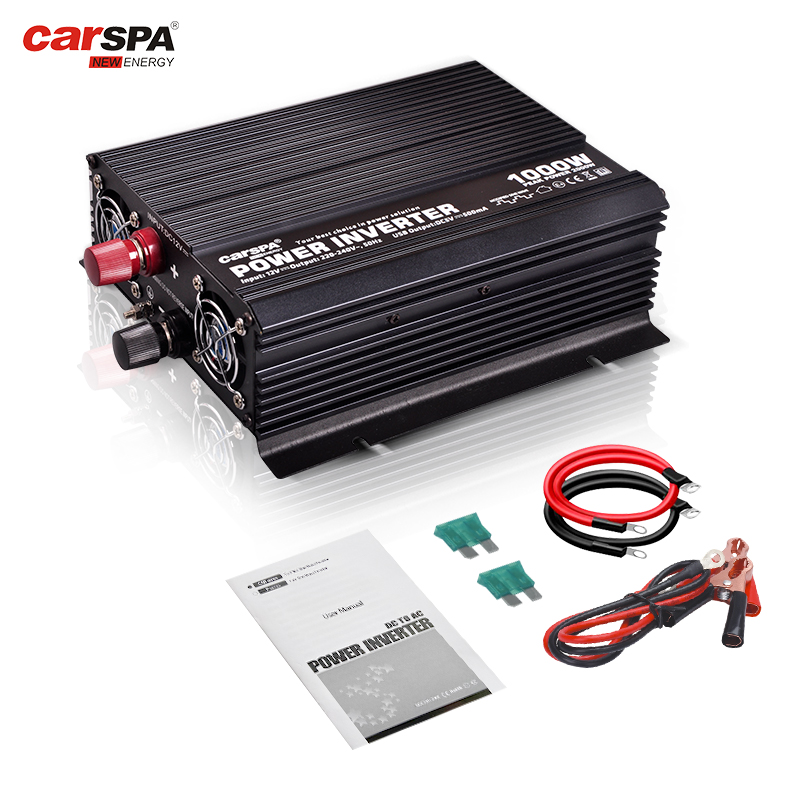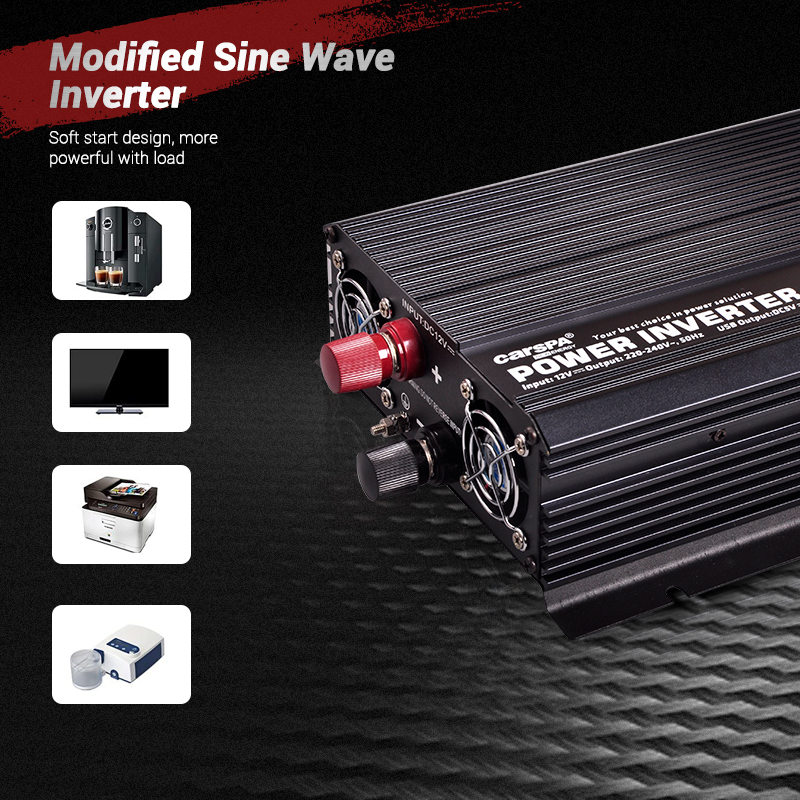Can a 1000W power inverter charge a 12 volt 200Ah battery or a 24 volt 200Ah battery?
In the process of using inverters and batteries, many people may have such questions: Can a 1000W power inverter charge a 12 volt or 24 volt 200Ah battery? This not only involves the matching of the inverter power and battery capacity, but also the overall efficiency of the equipment, charging time and various factors in practical applications. This article will help you understand the coordination between inverters and batteries and their effects in practical applications by analyzing these issues in detail.
1. What are the basic principles and uses of 1000-watt power inverters?
Before discussing whether inverters can charge batteries, we first need to understand the basic principles of inverters and their role in power systems.
Working principle of inverters
An inverter is an electrical device that converts direct current (DC) into alternating current (AC). Normally, the DC power provided by batteries or solar panels cannot be directly supplied to most household appliances because these appliances usually require AC power. Therefore, the role of the inverter is to convert DC power into AC power that can be used by devices.
Taking a 1000W inverter as an example, it can power electrical devices with a power of no more than 1000W. This means that it can support the use of small household appliances such as TVs, laptops, fans, etc. However, the main function of the inverter is to provide AC power, not to charge the battery.
The difference between inverter and charger
It is important to distinguish the functions of the inverter and the charger. The charger is specifically used to convert AC power to DC power and charge the battery. The main task of the inverter is to convert DC power to AC power and power the electrical appliances. Therefore, strictly speaking, the inverter itself does not have the function of charging the battery.
Practical application in the system
Inverters are usually used in off-grid power supply systems, such as RVs, boats, solar power generation systems, etc. In these systems, the battery is used as an energy storage device, and the inverter converts the DC power in the battery into AC power to supply the electrical appliances. In order to achieve battery charging, additional charging equipment is usually required, such as a solar charge controller or AC-DC charger.
2. Can a 1000W power inverter charge a 12V 200Ah battery?
Considering that the main function of the inverter is to convert DC to AC, charging the battery requires an additional device. However, if the system already includes the necessary charger, what is the role of the inverter in this system?
Typical configuration of the system
In an off-grid power supply system, the following devices are usually present:
·Battery: stores electrical energy and provides DC power.
·Inverter: converts DC to AC for use by equipment.
·Charger: converts AC to DC to charge the battery.
In this configuration, the inverter does not directly participate in the battery charging process, and the charging work is mainly done by the charger. If a 1000W power inverter is used and equipped with a suitable charger, the system can successfully charge a 12V 200Ah battery.
Calculation of battery capacity and charging time
Assume that we have a standard charger with a charging current of 20 amps. We can calculate the charging time by the following formula:
Charging time (hours) = battery capacity (Ah) / charging current (A)
For a 200Ah battery:
Charging time = 200Ah/20A = 10 hours
This calculation means that, ideally, the charger can fully charge the battery within 10 hours. However, the actual charging time may also be affected by many factors, such as the efficiency of the charger, temperature, battery health, etc.
Consideration of system efficiency
Although the 1000 watt power inverter can support the operation of most small appliances, the inverter itself cannot directly charge the battery. If the system needs to charge the battery, a dedicated charging device is usually used. For example, when using solar panels, a solar charge controller is used to charge the battery through the controller, and the inverter is responsible for converting the battery power into AC power.
Therefore, for a 12V 200Ah battery, the 1000W power inverter cannot charge it directly, but it can be used as part of the power supply system to provide power support for the entire system in conjunction with other devices.
3. Can a 1000W power inverter charge a 24V 200Ah battery?
Next, let's discuss the case of a 24V 200Ah battery. Compared to a 12V battery, a 24V battery has a higher voltage at the same capacity, which means it can store more energy at the same current.
Advantages of a 24V battery system
The biggest advantage of a 24V battery system over a 12V system is that it can provide a higher voltage, which results in a smaller current at the same power demand. Smaller current means lower cable losses and a more efficient system.
Choice of charger
Like a 12V battery system, a 24V system also requires a dedicated charger to complete the charging process. Assuming that the charging current of the charger is 10 amperes, the charging time of a 24 volt 200Ah battery can be calculated by the following formula:
Charging time (hours) = battery capacity (Ah) / charging current (A)
For a 200Ah battery:
Charging time = 200Ah/10A = 20 hours
This calculation shows that the ideal charging time for a 24 volt 200Ah battery is 20 hours. Considering the efficiency of the charger and other external factors, the actual charging time may vary.
The role of the inverter in the 24 volt system
Similar to the 12 volt system, the 1000W power inverter does not directly undertake the charging task in the 24 volt system, but is responsible for converting the DC power in the battery into AC power to supply electrical appliances. Therefore, in order to charge a 24 volt 200Ah battery, an adapted charger is still required.
It is worth noting that since the 24 volt system performs better under high power demand, the 1000W power inverter can more efficiently convert the energy of the 24 volt battery into AC power, reducing losses relative to the 12 volt system.
4. How to optimize the coordination between 1000W power inverter and battery?
Although the inverter cannot charge the battery directly, in system design, optimizing the coordination between the inverter and the battery can improve the efficiency and stability of the overall system.
Choose an appropriate charger
Whether it is a 12V or 24V battery system, it is crucial to choose an efficient charger. The charging current, efficiency and protection function of the charger will directly affect the charging time and life of the battery. It is recommended to choose an intelligent charger with multiple protection functions, which can automatically cut off the power supply when the battery is full to prevent overcharging and battery damage.
Power management of the inverter
The 1000W power inverter is suitable for scenarios with low power requirements, such as RVs, camping equipment or small household appliances. In actual use, reasonably distributing the load of the inverter and avoiding overload operation can not only extend the service life of the inverter, but also ensure the stability of the system. For example, high-power appliances can be used in time periods to reduce the impact of instantaneous high loads on the inverter and battery.
Comprehensively consider the overall efficiency of the system
When designing and using the power supply system, it is necessary to comprehensively consider the efficiency of each component, including the charging and discharging efficiency of the battery, the conversion efficiency of the inverter, and the transmission loss of the cable. By optimizing these parameters, the overall efficiency of the system can be significantly improved, the battery life can be extended, and energy waste can be reduced.
Consider different application scenarios
In different application scenarios, the way the inverter and battery cooperate will also be different. The following are several typical application scenarios and their requirements for inverter and battery systems:
RV and outdoor camping
In RV or outdoor camping, power demand is usually concentrated in lighting, refrigerators, mobile device charging, etc. A 1000W power inverter can easily meet these needs, especially when using 12V or 24V batteries. The system design should consider the balance between endurance and equipment load. To ensure that the battery can supply power for a long time, it is crucial to choose the right charger and manage the battery's discharge depth.
Off-grid solar power generation system
In an off-grid solar power generation system, solar panels, charge controllers, inverters, and batteries are usually used to form a complete power system. Solar panels charge the battery, while the inverter converts the DC power in the battery into AC power for use in homes or small facilities. 24V battery systems are more common in this scenario because they can handle the needs of high-power equipment more efficiently.
In this system, the selection of inverters and the matching of battery capacity are particularly important. For example, if the load often exceeds 1000W, you may need to consider a higher-power inverter or increase the battery capacity to ensure the reliability and continuous power supply of the system.
Power supply for small industrial equipment
In some small industrial scenarios, inverters and battery systems can be used for emergency power supply or as a backup for the main power system. In this application, the stability and fast response of the system are key. A 1000W RV inverter can usually meet the power needs of some small machinery or control systems, but in actual applications, it should be ensured that the output of the inverter is stable and the battery system can provide sufficient energy support.
By properly configuring batteries and inverters, combined with efficient chargers, the system can provide stable and continuous power when needed, avoiding production stagnation or equipment damage caused by power outages.
Future development and technology trends
With the continuous development of power technology, inverters and battery systems will be more and more widely used in various fields. In the future, we can foresee the following development trends:
Intelligent management of inverters
Inverters in the future will be more intelligent and can automatically adjust the output power according to the load demand to improve the overall efficiency. At the same time, by integrating with the battery management system (BMS), the inverter will be able to better monitor the battery status, optimize the charging and discharging process, and extend the battery life.
Application of new battery technology
The development of lithium batteries, solid-state batteries and other new battery technologies will further improve the energy density and efficiency of the system. As these technologies mature, inverters and battery systems will be able to provide longer battery life, faster charging speeds and higher safety.
More efficient charging solutions
Future charging technology will be more efficient and can charge large-capacity batteries in a short time. Whether it is used for 12V or 24V battery systems, the advancement of chargers will significantly shorten the charging time and reduce energy loss, thereby improving the operating efficiency of the entire system.
Conclusion
1000W power inverters play an important role in power supply systems, especially in small and medium-sized power demand application scenarios. Although the inverter itself cannot directly charge a 12V or 24V 200Ah battery, by combining it with an efficient charger, the inverter can provide these batteries with stable power output to meet diverse power needs.
When designing and using the power supply system, rationally configuring the inverter and battery system, optimizing the performance of the charger, and taking into account the needs of different application scenarios can significantly improve the efficiency and reliability of the system. In the future, with the continuous advancement of technology, inverters and battery systems will demonstrate their unique value in more fields, providing more intelligent and efficient power solutions for our lives and work.









